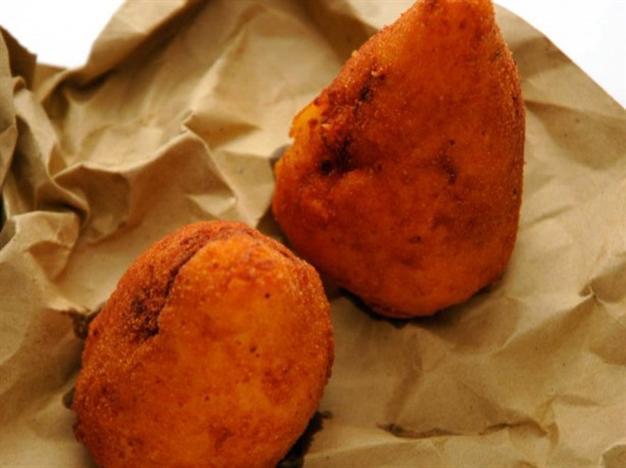Mysterious golden ball
Aylin Öney Tan - aylinoneytan@yahoo.com

My napkin was gently folded like a bundle. As I cradled it in my palms I felt the warmth inside. It was as if it were still sizzling in deep oil. As I unfolded the layers of linen, I noticed that my golden fried ball was slightly pointed on one end. That made me curious about the cook; it was surely a clue about his home country.
The folded napkin surprise was a complimentary gesture by Sebastiano Spriveri, chef at the Four Seasons Bosphorus, Istanbul. I knew that he was of Sicilian origin, but the particular shape of that wonderful fried rice ball was telling me that he must be from southern or eastern Sicily. Fried rice balls are called arancini, coming from arancia, the word for orange in Italian, meaning little oranges. They are mostly a bar snack though sometimes also sold in street festivals and are mostly enjoyed freshly fried, piping hot and roughly wrapped in a piece of paper. Practically, they are rice croquettes, usually made from leftover risotto, filled with a choice stuffing. The inside is soft with a rich meat ragù or molten lava-like melting cheese, wonderfully contrasting the crisp outside. They do resemble little oranges, getting their bright orange color from golden frying and the bright yellow of saffron risotto.
If they have a mozzarella filling, when you split the ball in half, the cheese tends to form long oozing threads between the semi-spheres of the ball, making it look like old-fashioned corded candlestick telephones. They are then called supplì al telefono, a name preferred in Rome. Either as Roman supplì or Sicilian arancini, they are very Italian, but there is a mystery connected to their history. They are close relatives with our “içli köfte,” stuffed meatballs, sharing the same ancestry and the same concept: a stuffing encased within a grain-based outer shell. In our case, the stuffing is more abundant, meatier and saucier, with a much thinner and crispier bulgur shell; whereas in the Italian version, the stuffing is lesser, the rice section thicker and softer, with the crispness only achieved by the bread crumb coating. However, the idea is the same and they are both related to Middle Eastern kibbeh. When one travels more east and south in Sicily, the arancini are no longer orange shaped, but pointed at one end, drastically looking like their Middle Eastern cousins. Actually, they are said to have originated under the Arab influence dating back to the 10th century. Over the centuries they became a part of the Sicilian identity, so much so that they were even featured in Sicilian literature, as the favorite savory snack of the island.
The last of the mystery stories of inspector Montalbano by the famous Sicilian writer Andrea Camilleri is titled “Gli Arancini di Montalbano” (“Montalbano’s Croquettes”), which gives a very long description of how to make the perfect arancini. The inspector is known for having a soft spot for good traditional Sicilian food; in particular, he cannot resist the homemade arancini of his housekeeper, Adelina Cirrinciò. However, her sublime croquettes require two days to make. First, a risotto is made and left to cool, later to be mixed with parmesan and raw eggs. For the filling, a ragù of equal parts pork and veal is slow cooked with onions and tomatoes, plus diced celery, carrots, parsley and basil. A béchamel sauce is also made to bind the filling together. Lastly, young tender peas are boiled to be added to the filling. Meanwhile, the inspector is entangled in problems related with Adelina’s two sons, who were just released from jail and got in trouble again. The making process of the golden fried balls is as exciting (if not more) as the mystery the inspector tries to solve.
Munching my golden “arancino,” I kept remembering the mysteries of the legendary inspector Montalbano. Inspired by him, I solved my own little mystery, hinted at in the shape of my croquette. I was right; Chef Spriveri was from Noto in the most southeastern corner of Sicily!
Fork of the Week
Aqua restaurant at the Four Seasons Bosphorus is switching to their summer menu as of tonight. Some dishes are typical summer guilty pleasures inspired by Italian street food. Apart from the arancini, another delight is the “Mozzarella in Carrozza,” breaded and fried mozzarella pockets filled with anchovies, tomatoes and basil. But the most delightful of all street food-inspired ideas is their new Pizza Delivery Boxes, a brilliant innovation of F&B manager Khalid Bseiso. If you have a dip in their seaside pool, you may order your special delivery pizza from the wood fired oven, and just imagine yourself ordering it from the other side of the pond, from Italy.
Cork of the Week
If we’re talking about Sicily, the most important red wine grape of Sicily, the lovely Nero d’Avola, finds itself perfectly at home in Urla, Turkey. The owner of Urla wines, Can Ortabaş, is a crazy entrepreneur; he not only brought the Sicilian grape to Turkey, but also revived the local Urla black grape and happily married them in the lively Nero d’Avola & Urla Karası coupage.
 My napkin was gently folded like a bundle. As I cradled it in my palms I felt the warmth inside. It was as if it were still sizzling in deep oil. As I unfolded the layers of linen, I noticed that my golden fried ball was slightly pointed on one end. That made me curious about the cook; it was surely a clue about his home country.
My napkin was gently folded like a bundle. As I cradled it in my palms I felt the warmth inside. It was as if it were still sizzling in deep oil. As I unfolded the layers of linen, I noticed that my golden fried ball was slightly pointed on one end. That made me curious about the cook; it was surely a clue about his home country.